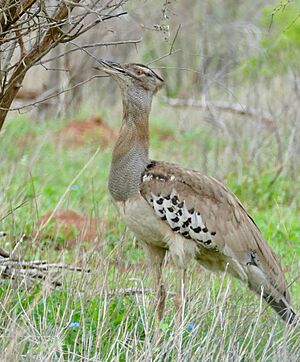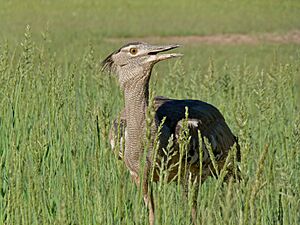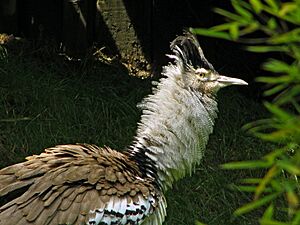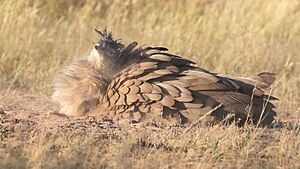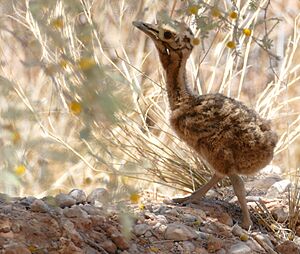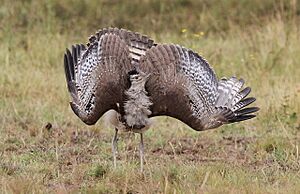Kori bustard facts for kids
Quick facts for kids Kori bustard |
|
|---|---|
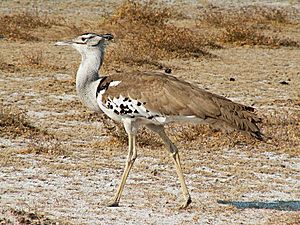 |
|
| Nominate subspecies, taken in Etosha National Park, Namibia | |
| Conservation status | |
| Scientific classification |
The kori bustard (Ardeotis kori) is the biggest flying bird found in Africa. It belongs to the bustard family, which are all found in the Old World (Africa, Asia, and Europe). The male kori bustard might even be the heaviest living animal that can fly!
Like most bustards, this bird lives on the ground. It eats many different things, meaning it's an omnivore. Male kori bustards are much heavier than females. They try to mate with many females and then don't help raise the young. Their nest is just a small dip in the ground, often hidden by trees or bushes.
Contents
Understanding the Kori Bustard: Taxonomy
The English naturalist William John Burchell first described the kori bustard in 1822. The name kori comes from the Tswana name for this bird, which is Kgori.
Scientists recognize two main types, or subspecies, of the kori bustard:
- Ardeotis kori kori: This type is lighter in color. It lives in Botswana, Zimbabwe, Namibia, southern Angola, South Africa, and Mozambique.
- Ardeotis kori struthiunculus: This type is sometimes called the "Somali kori." It lives in Ethiopia, Uganda, South Sudan, Kenya, and Tanzania. These two types are separated by the miombo woodlands in central Africa. The "Somali kori" has a bolder pattern on its head and more black and white on its wings. Both types are similar in size, but A. k. struthiunculus might be a little bigger. Some scientists think it could even be a separate species.
Physical Features: What Does a Kori Bustard Look Like?
Kori bustards are hard to spot because their colors help them blend in. They are mostly grey and brown, with fine black and white patterns. Their upper body and neck have a mix of black and greyish-buff colors. Their belly feathers are bolder, with white, black, and buff.
They have a blackish crest on their head, but females have less black. There's a white stripe above their eye. Their chin, throat, and neck are whitish with thin black lines. A black band goes around the back of their neck and onto their chest. The feathers around their neck are loose, making their neck look thicker than it is. Their belly is white, and their tail has wide bands of brownish-grey and white.
Their feathers contain special chemicals called porphyrins. These make the feathers look a bit pinkish at the base, especially when they shed them. Kori bustards have a large head and long legs. Their eyes are pale yellow, and their beak is light greenish-horn colored. Their legs are yellowish, and their feet have three toes pointing forward.
Female kori bustards look similar but are much smaller. They are about 20–30% smaller in length and often weigh 2–3 times less than males. Females also have thinner legs and necks. Young kori bustards look like females but are browner. Young males are larger than young females and can be as big as adult males. However, they are less bulky, with a thinner neck, shorter head crest, paler eyes, and a darker back.
Size and Weight: How Big Are Kori Bustards?
Male kori bustards are very large birds. They can be 105 to 135 cm (3 ft 5 in to 4 ft 5 in) long and have a wingspan of 230 to 275 cm (7 ft 7 in to 9 ft 0 in). Males usually weigh between 7 and 18 kg (15 and 40 lb). Some very large males can weigh up to 16 to 19 kg (35 to 42 lb), and a few rare ones might even reach 20 kg (44 lb).
Male kori bustards are considered one of the heaviest flying animals on Earth. Only male great bustards are similar in weight. This makes them the two largest bustards and possibly the heaviest living birds that can fly. The kori bustard is Africa's second largest bird, after the ostrich.
Female kori bustards are smaller, weighing an average of 4.8 to 6.1 kg (11 to 13 lb). Their full weight range is 3 to 7 kg (6.6 to 15.4 lb). Females are about 90 to 112 cm (2 ft 11 in to 3 ft 8 in) long, with a wingspan of 177 to 220 cm (5 ft 10 in to 7 ft 3 in). The weight of these birds can change quite a bit depending on how much rain there has been.
Similar Birds: Telling Kori Bustards Apart
The kori bustard's large size and dark crest usually help identify it among other bustards. However, East Africa has many different large bustard species. Kori bustards are greyer and don't have the reddish-brown neck and back that Denham's bustard and Ludwig's bustard have. When flying, kori bustards have uniformly grey upper wings, unlike these other bustards which have white markings.
The Arabian bustard is quite similar in size to the kori bustard. But the Arabian bustard has white tips on its wing feathers, a browner back, and very fine lines on its neck. It also lacks the black base to the neck and black in the wing feathers that the kori bustard has.
Where Kori Bustards Live: Distribution and Habitat
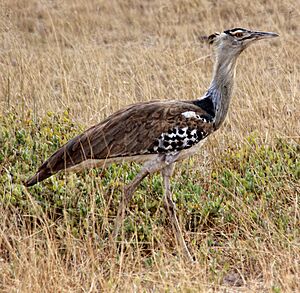
Kori bustards live across southern Africa, avoiding thick forests. They are common in Botswana and Namibia. You can also find them in southern Angola, parts of Zambia, and in Zimbabwe. Their range extends into southern Mozambique and eastern South Africa. They are less common in some parts of South Africa but can be found in the interior of the Western and Eastern Cape Provinces. They don't live in coastal areas or high mountains.
This species is also common in Tanzania, especially in Ngorongoro National Park and Serengeti National Park. Another group lives in the deserts and savannas of northeastern Africa, including South Sudan, northern Somalia, Ethiopia, Kenya, Tanzania, and Uganda. Kenya might have the largest population of kori bustards.
Kori bustards usually stay in one area, but they might move around a bit to find food or water after rainfall. These movements often happen at night.
They prefer open, grassy areas, especially those with sandy soil and short grass. They like to be near scattered trees or bushes for cover. You can find them in plains, dry plateaus, grasslands, and semi-deserts. They live in places where rainfall is low, usually between 100 and 600 mm (3.9 and 23.6 in) per year. They often follow wildfires or herds of grazing animals to find food in the shorter grass. They can also be seen in farm fields, especially wheat fields with a few trees. Kori bustards need a lot of open space to take off, so they avoid thick forests. In dry grasslands, they stay near dry riverbeds where trees offer shade.
Kori Bustard Behaviour
Kori bustards spend most of their time on the ground, walking up to 70% of the time. They sometimes look for food in low bushes and trees. They are usually watchful and careful birds. Their behavior can change; sometimes they are very shy and run or hide if they sense danger. Other times, they can be quite brave around humans.
They walk slowly and carefully. If they see something unusual, they try to sneak away quietly, holding their head at a strange angle. Because they are large and heavy, they try to avoid flying if possible. If they must fly, they run first and then take off with strong wingbeats. Once in the air, they fly more easily with slow, steady wingbeats, their neck stretched out and legs folded. They usually fly low and land again nearby. When landing, they keep their wings spread until they slow down to a walk.
Kori bustards don't have an oil gland for preening. Instead, they produce a special powder to keep their feathers clean. They also enjoy sunbathing and dust bathing. This bird has a loud, booming call during mating season, often heard before sunrise. It can be heard from far away.
Kori bustards usually stay in one place, but they might move around depending on rainfall. These movements happen at night. In Etosha National Park, they have been seen moving up to 85 km (53 mi) between different habitats. Young and adult males often move after the breeding season, but females usually don't. Kori bustards typically feed in the morning and evening, spending the rest of the day resting in the shade.
Voice and Calls
Kori bustards are not as noisy as some other bustards. They are usually quiet. But if they are alarmed, both males and females make a loud, growling bark. This call sounds like ca-caa-ca and is repeated several times for up to 10 minutes. This call can be heard from far away. Females with young and males fighting often make this call. Even chicks as young as two weeks old will make this alarm call if scared.
The male's mating call is a deep, booming sound like woum-woum-woum-woum or oom-oom-oom. This call ends with a bill-snapping sound, which you can only hear if you are close. Outside of mating displays, kori bustards are often silent. Females sometimes make a high alarm call. They might also make a deep vum sound when they take off.
Social Life: How Kori Bustards Interact
During the mating season, kori bustards are usually alone, except for the breeding pair. At other times, they are somewhat social. They are often found in groups of 5 to 6 birds, but sometimes groups can have up to 40 individuals. Larger groups might gather around a lot of food or at watering holes.
In groups, birds often stay quite far apart, usually about 100 m (330 ft) from each other. Groups that are looking for food are often made up of birds of the same sex. These groups don't last long and often break up after a few days. Being in groups is thought to be helpful for safety against predators and for finding good food sources.
Feeding Habits: What Kori Bustards Eat
Kori bustards walk slowly and calmly when they are looking for food. They pick things off the ground with their beaks. They are most active in the early morning and late evening. Kori bustards eat a wide variety of foods.
Insects are a very important part of their diet. They often eat locusts, grasshoppers, dung beetles, and caterpillars. They might follow large grazing animals to catch insects that are disturbed by them or to find edible bugs in their droppings. When there are many locusts or caterpillars, kori bustards will eat a lot of them. Other insects they eat include bush-crickets, termites, and solifuges. They might also eat scorpions and molluscs if they find them.
They also regularly eat small animals with backbones. These can include lizards, chameleons, small snakes, small mammals (especially rodents), and even bird eggs and baby birds. Sometimes, they might eat dead animals, especially those killed in grass fires.
Plants are also an important food source. They eat grasses and their seeds a lot. They also eat other seeds, berries, roots, bulbs, flowers, wild melons, and green leaves. Kori bustards really like Acacia gum. This is why they are sometimes called Gompou in Afrikaans, which means "gum peacock." They drink water regularly if they can find it, but they can live as far as 40 km (25 mi) from water sources. Unusually, they suck up water instead of scooping it.
Reproduction and Life Cycle
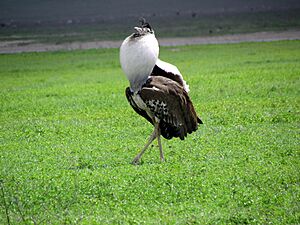
The two types of Kori bustards have different breeding seasons. Generally, A. k. struthiunculus breeds from December to August, and A. k. kori breeds from September to February. Breeding is closely linked to rainfall. In dry years, they might not breed much, or at all.
Kori bustards have a special way of mating called lek mating. This means one male displays to attract several females and mates with all of them. Males display at special spots, using several different display areas. These displays usually happen in the mornings and evenings.
The male's courtship displays are very impressive and fancy. They help him show off to potential mates. Males hold their heads back, puff out their cheeks, and raise their crest. Their beak is open, and they inflate their throat pouches, making a white "balloon" on their throat. During this display, their food pipe swells up to four times its normal size. They also puff out their neck feathers, showing their white underside. This white can be seen up to 1 km (0.62 mi) away!
Their wings droop, and their tails are raised up and forward over their backs, like a turkey. They walk with an exaggerated bouncing step. When displaying, they stride around with puffed-out necks, fanned tails, and wings pointed downward. They also make a low booming sound when their neck is fully inflated and snap their beaks open and shut.
Several males might gather to display, but usually one is dominant. Other males won't display in his presence and will move away. Females visit the displaying males and choose the one with the most impressive display. Sometimes, fights between males can be serious during mating season, especially when they are competing for display areas. They might crash into each other and stab with their beaks. They can push each other chest-to-chest for up to 30 minutes.
After the display, the female lies down next to the dominant male. He stands over her for 5–10 minutes, stepping side to side and pecking her head slowly. She pulls back with each peck. Then he lowers himself and continues pecking until he mounts her with wings spread. Mating lasts only a few seconds, after which both birds stand apart and shake their feathers. The female sometimes barks, and the male continues his display.
Like all bustards, the female doesn't build a fancy nest. She lays her eggs on the ground in a shallow, unlined dip. This nest is usually within 4 m (13 ft) of a tree, bush, termite mound, or rocks. The dip can be 300–450 mm (12–18 in) wide and is almost completely covered by the female when she is sitting on it. Because they are on the ground, nests are hard to find unless you stumble upon them. The same spot is sometimes used again in later years. The kori bustard nests alone, and females don't seem to defend a territory.
Usually, two eggs are laid, but sometimes only 1 or 3. The number of eggs likely depends on how much food is available. The eggs are camouflaged with dark buff, brown, or olive colors, and have brown, grey, and pale purple spots. They are somewhat shiny and have a bumpy surface. Eggs are about 81 to 86 mm (3.2 to 3.4 in) tall and 58 to 61 mm (2.3 to 2.4 in) wide. Each egg weighs about 149 g (5.3 oz).
The female alone takes care of the eggs. She stays at the nest 98% of the time, rarely eating and never drinking. She occasionally stretches her legs and raises her wings. The female regularly turns the eggs with her beak. Her dull, earth-colored feathers help her blend in perfectly. She sometimes picks up bits of plants and drops them on her back to improve her camouflage. If she needs to eat briefly, she goes to and from the nest with a swift, silent, crouching walk. If someone approaches, she either quietly slips away from the nest or sits very still, only flying off at the last moment.
The eggs hatch in 23 to 30 days. The young are born ready to move around and are very well camouflaged. Their faces are reddish-brown, and their heads are mottled black and reddish-brown. A wide white stripe above their eye meets at the back of their neck. Their neck is white with black stripes. Their upper parts are reddish-brown and black with three black lines down their back. Their undersides are whitish.
When the chicks hatch, the mother brings them a steady stream of soft food that they can eat easily. Baby kori bustards weigh 78 to 116 g (2.8 to 4.1 oz) on their first day but grow quickly. They can follow their mother around just a few hours after hatching. After a few weeks, the young actively look for food closely with their mothers. They learn to fly at 4 to 5 weeks old, but they aren't confident flyers until 3 to 4 months old.
On average, about 67% of eggs hatch successfully, thanks to the nests' good camouflage. About one of the two young survives to adulthood. In Namibia and Tanzania, breeding success is much lower during droughts. Most young birds leave their mothers in their second year of life. They don't start breeding until they are fully grown, at three to four years old. Wild kori bustards' lifespan is not known, but they can live to at least 26 or possibly 28 years old in zoos.
Interactions with Other Animals
Kori bustards are often found in areas with many antelopes and other wild animals. In Tanzania, they often follow blue wildebeest herds. They eat the small mammals and insects that the wildebeest disturb. Sometimes, kori bustards let southern carmine bee-eaters and northern carmine bee-eaters ride on their backs as they walk through the grass. The bee-eaters catch insects that the bustard stirs up. This is common in Chobe National Park, Botswana.
Kori bustards have been seen acting aggressively towards other animals at watering holes. They might raise their crests, open their wings, and peck. They have shown aggression towards red-crested korhaans, springbok, plains zebra, and gemsbok.
Being a large, ground-dwelling bird, the kori bustard faces many predators in Africa. These include Leopards, caracals, cheetahs, lions, spotted hyenas, African rock pythons, and jackals. While large predators usually hunt bigger mammals, caracals sometimes ambush adult kori bustards. There's also a report of two black-backed jackals taking down an adult male kori bustard. Other mammals like warthogs, mongoose, and baboons might eat eggs and small chicks.
While too big for most predatory birds, martial eagles can be a serious threat, even to adult male kori bustards that are twice their weight. In one case, a martial eagle attacked an adult kori bustard. Both birds were hurt, but the bustard was more seriously injured with a broken wing. It died the next morning. Chicks are most vulnerable to predators. Many, despite their camouflage and their mother's protection, are eaten by jackals and leopards at night. Up to 82% of kori bustard chicks die in their first year.
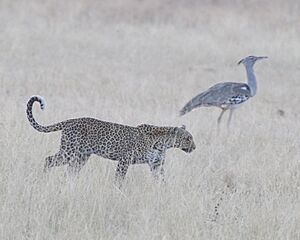
When alarmed, kori bustards bark and spread their tail and wings to look bigger. Adults will growl if their young are threatened. The male's display might make him more noticeable to larger predators like hyenas or lions.
Conservation Status: How Kori Bustards Are Doing

The kori bustard is generally a somewhat rare bird. It is listed as "Vulnerable" in some conservation books, meaning its numbers are expected to drop. In South Africa, it is predicted to decline by 10% in the next three generations. In protected areas, they can be common. Some healthy populations also exist outside protected areas, for example in Ethiopia and Sudan, and around Lake Natron in Tanzania. However, in these areas, the birds are hunted.
Hunting has greatly reduced their numbers. They were traditionally caught using traps with Acacia gum. Even though they are no longer classified as game birds, people still sometimes eat them. In Namibia, they are called the "Christmas turkey," and in South Africa, the "Kalahari Kentucky." It is hard to control the hunting of bustards.
The kori bustard is now uncommon outside major protected areas. Losing their habitat is a big problem for them. This is made worse by too much grazing by livestock and by farms expanding. Poisons used to control locusts can also harm them. Collisions with overhead power lines regularly kill kori bustards. For example, a 10 km (6.2 mi) stretch of power lines in the Karoo killed 22 kori bustards in just five months. Kori bustards tend to avoid areas where humans are very active.
However, because the kori bustard lives across a very large area, and its decline is thought to be relatively slow, it is not currently listed in a highly threatened category on the IUCN Red List.
The species is important in many African cultures. This is because of its impressive size, the males' amazing displays, or how well the nesting female hides. The kori bustard appears in dances and songs of the San people of Botswana. Paintings of these bustards are also found in ancient San rock art. In Botswana, it was associated with royalty because only the royal family could eat it. Since 2014, it has also been the national bird of Botswana.
See also
- Sara Hallager - an ornithologist who studies kori bustards




